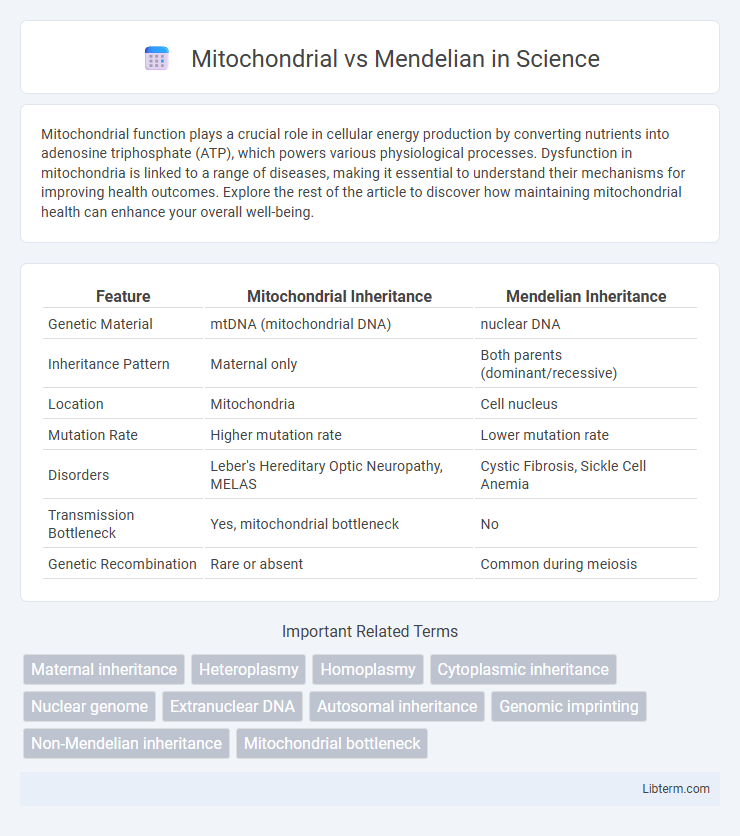Mitochondrial function plays a crucial role in cellular energy production by converting nutrients into adenosine triphosphate (ATP), which powers various physiological processes. Dysfunction in mitochondria is linked to a range of diseases, making it essential to understand their mechanisms for improving health outcomes. Explore the rest of the article to discover how maintaining mitochondrial health can enhance your overall well-being.
Table of Comparison
| Feature | Mitochondrial Inheritance | Mendelian Inheritance |
|---|---|---|
| Genetic Material | mtDNA (mitochondrial DNA) | nuclear DNA |
| Inheritance Pattern | Maternal only | Both parents (dominant/recessive) |
| Location | Mitochondria | Cell nucleus |
| Mutation Rate | Higher mutation rate | Lower mutation rate |
| Disorders | Leber's Hereditary Optic Neuropathy, MELAS | Cystic Fibrosis, Sickle Cell Anemia |
| Transmission Bottleneck | Yes, mitochondrial bottleneck | No |
| Genetic Recombination | Rare or absent | Common during meiosis |
Understanding Mitochondrial and Mendelian Inheritance
Mitochondrial inheritance involves genes passed exclusively through maternal mitochondria, affecting cellular energy production and often linked to metabolic disorders. Mendelian inheritance follows principles of dominant and recessive gene transmission from both parents, predicting traits based on allele combinations in nuclear DNA. Understanding these contrasting inheritance patterns is crucial for diagnosing genetic diseases and developing targeted therapies.
Key Differences in Genetic Transmission
Mitochondrial inheritance is exclusively maternal, as mitochondria are passed from mother to offspring through the egg, while Mendelian inheritance follows biparental transmission with genes inherited from both parents. Mitochondrial DNA (mtDNA) is circular, encodes 37 genes, and exhibits high mutation rates, whereas Mendelian genes reside on nuclear chromosomes and obey dominant, recessive, and co-dominant inheritance patterns. Disorders caused by mitochondrial DNA mutations often show heteroplasmy and variable expression, contrasting with Mendelian traits that typically have predictable inheritance patterns based on allele segregation.
Sources of Mutations: Mitochondrial vs Nuclear DNA
Mitochondrial DNA (mtDNA) mutations primarily arise from oxidative damage due to the high production of reactive oxygen species within the mitochondria, leading to a higher mutation rate compared to nuclear DNA. Nuclear DNA mutations follow Mendelian inheritance patterns and are often caused by replication errors, environmental factors, or exposure to mutagens, with efficient repair mechanisms mitigating mutation accumulation. The distinct sources and repair efficiencies contribute to the differing mutation rates and inheritance modes between mitochondrial and nuclear genomes.
Patterns of Disease Inheritance
Mitochondrial disease inheritance follows a maternal pattern because mitochondria and their DNA are transmitted exclusively from the mother to offspring, leading to all children inheriting mitochondrial mutations if present. Mendelian inheritance involves nuclear DNA and demonstrates autosomal dominant, autosomal recessive, or X-linked patterns, where gene variants can be passed from either parent according to classic segregation rules. Understanding these distinct patterns is crucial for diagnosing genetic disorders and predicting disease risk within families.
Clinical Manifestations and Examples
Mitochondrial diseases often present with multisystem involvement including muscle weakness, neurological deficits, and cardiomyopathy, caused by mutations in mitochondrial DNA affecting cellular energy production. Mendelian disorders follow autosomal dominant, recessive, or X-linked inheritance patterns and manifest in diverse clinical phenotypes such as cystic fibrosis (autosomal recessive) or Huntington's disease (autosomal dominant), with symptoms based on the specific gene mutation. Examples of mitochondrial disorders include Leber's Hereditary Optic Neuropathy (LHON) and MELAS, while Mendelian examples encompass phenylketonuria, Marfan syndrome, and hemophilia.
Diagnostic Approaches for Each Inheritance Type
Mitochondrial inheritance requires diagnostic approaches that involve analyzing mitochondrial DNA (mtDNA) mutations through techniques such as PCR-based assays, next-generation sequencing, and muscle biopsy for heteroplasmy levels. Mendelian inheritance diagnostics primarily utilize genomic DNA analysis, including whole exome sequencing, targeted gene panels, and linkage analysis to identify pathogenic variants in nuclear genes following autosomal dominant, recessive, or X-linked patterns. Both inheritance types benefit from family history assessment and genetic counseling to interpret variant significance and inheritance risks accurately.
Therapeutic Strategies: Tailoring to Genetic Origin
Therapeutic strategies differ significantly between mitochondrial and Mendelian disorders due to their distinct genetic origins; mitochondrial diseases often require approaches targeting mitochondrial DNA repair, replication, or metabolic function enhancement, such as gene therapy and mitochondrial replacement techniques. In contrast, Mendelian disorders benefit from gene editing tools like CRISPR-Cas9 and allele-specific treatments designed to correct or replace nuclear gene mutations. Precision medicine frameworks are critical to tailoring treatments effectively, emphasizing the importance of understanding the underlying genetic mechanisms to optimize outcomes.
Family History and Genetic Counseling
Mitochondrial inheritance involves mutations in mitochondrial DNA passed exclusively from mothers to all their offspring, impacting family history patterns distinctively compared to Mendelian inheritance, which follows autosomal dominant, autosomal recessive, or X-linked patterns. Genetic counseling for mitochondrial disorders requires detailed maternal lineage analysis and consideration of heteroplasmy effects, while Mendelian counseling emphasizes pedigree evaluation to assess carrier risks and recurrence probabilities. Accurate identification of inheritance type guides risk assessment, testing strategies, and reproductive decision-making in affected families.
Recent Advances in Genetic Research
Recent advances in genetic research have elucidated distinct inheritance patterns between mitochondrial and Mendelian genetics, emphasizing mitochondrial DNA's maternal lineage and unique mutation rates. Innovations in sequencing technologies, such as long-read and single-cell sequencing, have enhanced the detection of heteroplasmy and mitochondrial genome variations. These breakthroughs are pivotal for diagnosing mitochondrial disorders and understanding their complex interactions with nuclear Mendelian genes.
Implications for Future Treatments
Mitochondrial and Mendelian inheritance patterns influence future treatment strategies by dictating the genetic targets for therapy development. Mitochondrial diseases, caused by mutations in mitochondrial DNA, highlight the potential of gene replacement and mitochondrial replacement therapies to prevent transmission. Mendelian disorders, resulting from nuclear DNA mutations, benefit from advances in gene editing technologies like CRISPR to correct specific pathogenic variants.
Mitochondrial Infographic

 libterm.com
libterm.com